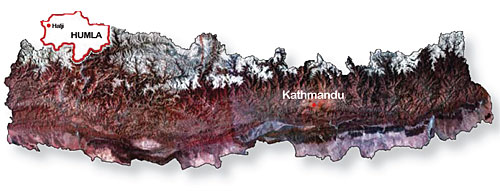 |
Humla is one of the most remote districts in Nepal, and in a remote corner of Humla lies the settlement of Halji in Limi VDC. On 30 June this village of 400 inhabitants was hit by a flash flood caused by a glacial lake bursting upstream.
 PICS: ASTRID HOVDEN Glacier snout that hides a lake beneath the ice. |
 Collapsed icefall that triggered the glacial lake burst. |
At around 4:30 pm there was a loud roar from up the valley, and everyone ran out of their houses. At first, the raging brown water was retained by the gabion walls, the last stretch of which was built only a month earlier. Soon, the embankments gave way and the water and the boulders raced towards the village with great force.
The ground shook and the water was nearly black because of the landslides along the banks. People managed to evacuate in time and move most of their belongings, but had to watch as their homes and fields were carried away.
 Meltpools downstream from the glacier. |
 |
Fortunately no lives were lost, but some livestock was taken by the flood as were two houses and 200 ropanis of farmlands. Some poorer families lost all their fields. Food aid will therefore be needed for the winter. Water mills, bridges and sections of the main trail through the valley and up to high pastures were washed away.
The disaster was caused by a glacial lake outburst flood (GLOF) in the mountains above Halji. Due to global warming the water level of many glacial lakes across the Himalaya have risen dangerously, and could overflow with devastating consequences. The flood at Halji which is the fifth since 2006 has occurrs every year on almost the same date at the end of June.
 The flood thunders down the Limi Valley. |
 Arrives at the village and takes away houses � |
The glacier lies on a plateau at 5,200-5,400m on the flanks of Mt Gurla Mandata in Tibet and there are five glacial lakes which feed into the river. But the flood was caused by another lake hidden under the glacier which is partly visible through a deep crevasse. Villagers who climbed the glacier just after the flood in 2009 say the lake was partly covered by a big ice sheet about 20-25 meters thick. Parts of this may have broken off and fallen into the lake last month, displacing huge amounts of water and causing the flood.
Halji village is constructed around the 11th century Rinchenling Monastery, one of the oldest in Nepal and a potential World Heritage Site. Because of the valley's scenic beauty and location on the pilgrimage path to Mount Kailash at the very end of the Great Himalayan Trail, it is also becoming an increasingly popular destination for trekkers. The village and its 1,000-year-old monastery are now threatened by future floods.
 �and farmlands. |
 The flood has altered the riverbed, threatening Halji village and its 1,000-year-old monastery. |
There is an urgent need to provide food and rebuild the homes of affected families, as well as to rehabilitate and strengthen the embankments before the next flood. Experts should also assess the risk of future outbursts of the glacial lake and develop a long term strategy to minimise the risks of a future, even bigger, disaster. Long term mitigation strategies may involve controlled drainage of the lake, building of further gabion walls to protect farmlands downstream by diverting water away from the village.
Astrid Hovden is a PhD fellow at the University of Oslo.
Read also:
Staying afloat
The sun is free for everyone??but not for Nepalis, it seems, ADAM FRIEDSOHN
"Do for nation"
Small amounts of money donated by a large amount of people goes a long way in Nepal


